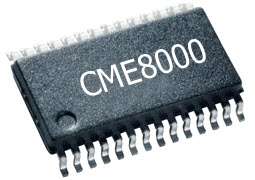Bicmos technology
BICMOS Technology
What is BiCMOS Technology?
While the whole semiconductor industry is excited about FinFET and FDSOI processor technologies, there is one semiconductor technology that considered by engineers as "the process for real men" and its called BiCMOS. This is one of the major semiconductor technology and is a highly developed technology.
BiCMOS technology combines Bipolar and CMOS semiconductors in a single integrated circuit. By holding the advantages of Bipolar and CMOS , BICMOS is able to accomplish VLSI circuits with speed-power-density performance previously unattainable with either technology individually.

The figure shown is the first analog/digital receiver IC and is a BiCMOS integrated receiver with very high sensitivity.
Advantages of BiCMOS technology:
- Since it is a combination of bipolar and CMOS technologies we can utilize BJT if speed is a critical parameter and we can use MOS if power is a critical parameter and it can drive high capacitance loads with reduced cycle time.
- BiCMOS has low power dissipation than bipolar technology alone.
- This technology found various applications in analog power managing circuits and amplifier circuits such as BiCMOS amplifier.
- It is well appropriate for input/ouput intensive applications, offers flexible inputs/outputs (TTL, CMOS and ECL).
- It has improved speed performance compared to CMOS technology alone.
- It has the bidirectional capability.
Drawbacks of BiCMOS technology:
- The fabrication process of this technology is combination of both the CMOS and bipolar technologies increasing the complexity.
- Due to increase in the complexity of the fabrication process, the cost of fabrication also increases.
- As there are more devices, hence, less lithography.
BiCMOS technology and Applications:
- It can be analyzed as AND function of high density and speed.
- This technology is used as an alternate of the previous bipolar, ECL and CMOS in the market.
- In certain applications (in which there is finite budget for power) the BiCMOS speed performance is better than the that of bipolar.
- This technology is well appropriate for the intensive input/output applications.
- The uses of BiCMOS were at first in RISC microprocessors rather than traditional CISC microprocessors.
- This technology excels its applications, mainly in two regions of microprocessors such as memory and input/output.
- It has a various applications in analog and digital systems, resulting in the single chip spanning the analog-digital boundary.
- It overpass the gap permitting course of action and circuit margins to be crossed.
- It can be utilized for sample and hold applications as it provides high impedance inputs.
- This is additionally used in applications such as adders, mixers, ADC and DAC.
- To overcome the limitations of bipolar and CMOS operational amplifiers the BiCMOS processes are used in designing the operational amplifiers.
Which foundry supports BiCMOS fabrication process today?
- ST
- IHP
- IBM
- XFAB
- TowerJazz
References:
A. Bellaovar and S. H. K. Embabi, "Scaling of Digital BiCMOS Circuits", 1989 Int. Electron Devices Meeting, pp. 572-575.
A. R. Alvarez, "Introduction to BiCMOS" in BiCMOS Technology and Applications, Kluwer Academic Publishers, 1989.
- ST
- IHP
- IBM
- XFAB
- TowerJazz
Author: Ayush Patidar

Useful information
ReplyDeleteExcellent information 👍
ReplyDeleteThank you
DeleteVery nice
ReplyDeleteInformative content!
ReplyDeleteThank you
DeleteNice content
ReplyDeleteThank you
DeleteInformative 👍
ReplyDeleteNice
ReplyDeleteNice
ReplyDeleteWell explained
ReplyDeleteWell explained
ReplyDeleteThank you
DeleteVery well written.
ReplyDeleteThank you
DeleteVery informative 💯
ReplyDeleteGreat work!!
ReplyDeleteThank you
DeleteVery informative
ReplyDeleteThank you
DeleteWell explained
ReplyDeleteThank you
DeleteVery well
ReplyDeleteThanks for the information
ReplyDeleteThank you
DeleteThank you bhai
ReplyDeleteThank you
DeleteThank you bhai
ReplyDeleteThank you
DeleteVery nice
ReplyDeleteVery Insightful!
ReplyDeleteThank you
DeleteWell explained
ReplyDeleteWell explained
ReplyDeleteThank you
Deletevery nice work
ReplyDeleteThank you
DeleteWorth a read, great work!
ReplyDeleteThank you
DeleteWorth the words very impressive
ReplyDeleteThank you
DeleteVery well explained
ReplyDeleteThank you
Deletegreat work 🙌🏻
ReplyDeleteThank you
DeleteGood work &
ReplyDeleteWell explained
Thank you
DeleteNice Explanation !!
ReplyDeleteThank you
DeleteVery well explained
ReplyDeleteThank you
DeleteBrilliant Described!!
ReplyDeleteWell Done !
ReplyDeleteThank you
DeleteVery well
ReplyDeleteVery informative ��
ReplyDeleteThank you
DeleteInformative👍👍
ReplyDeleteThank you
DeleteOutstanding work👍
ReplyDeleteVery Well explained
ReplyDeleteGreat Insight
ReplyDeleteWell explained
ReplyDeleteInformative quite. Please do keep uploading amazing content.
ReplyDeleteVery good .. 👍 explanations is to good
ReplyDeleteVery great to know much relevant
ReplyDeleteVery informative 💯
ReplyDeleteWell done really amazing
ReplyDeleteGreat insight
ReplyDeleteThank you
DeleteNicely Explained
ReplyDeleteThank you
DeleteVery Informative
ReplyDeleteIt's really amazing ayush keep doing 💯
ReplyDeleteThank you
Deleteamazing write up
ReplyDeleteThank you
DeleteExplained pretty well.
ReplyDeleteLooking forward to have some more insightful things.
Ya sure why not?
DeleteThis comment has been removed by the author.
ReplyDeleteThis comment has been removed by the author.
ReplyDeleteGreat insight
ReplyDeleteMast
ReplyDeleteGreat work dude keep it up
ReplyDeleteVery informative !!!!!
ReplyDeleteNice content!!
ReplyDeleteSuch a interesting article very informative
ReplyDeletegood insight
ReplyDeleteGood work and informative 👍
ReplyDelete